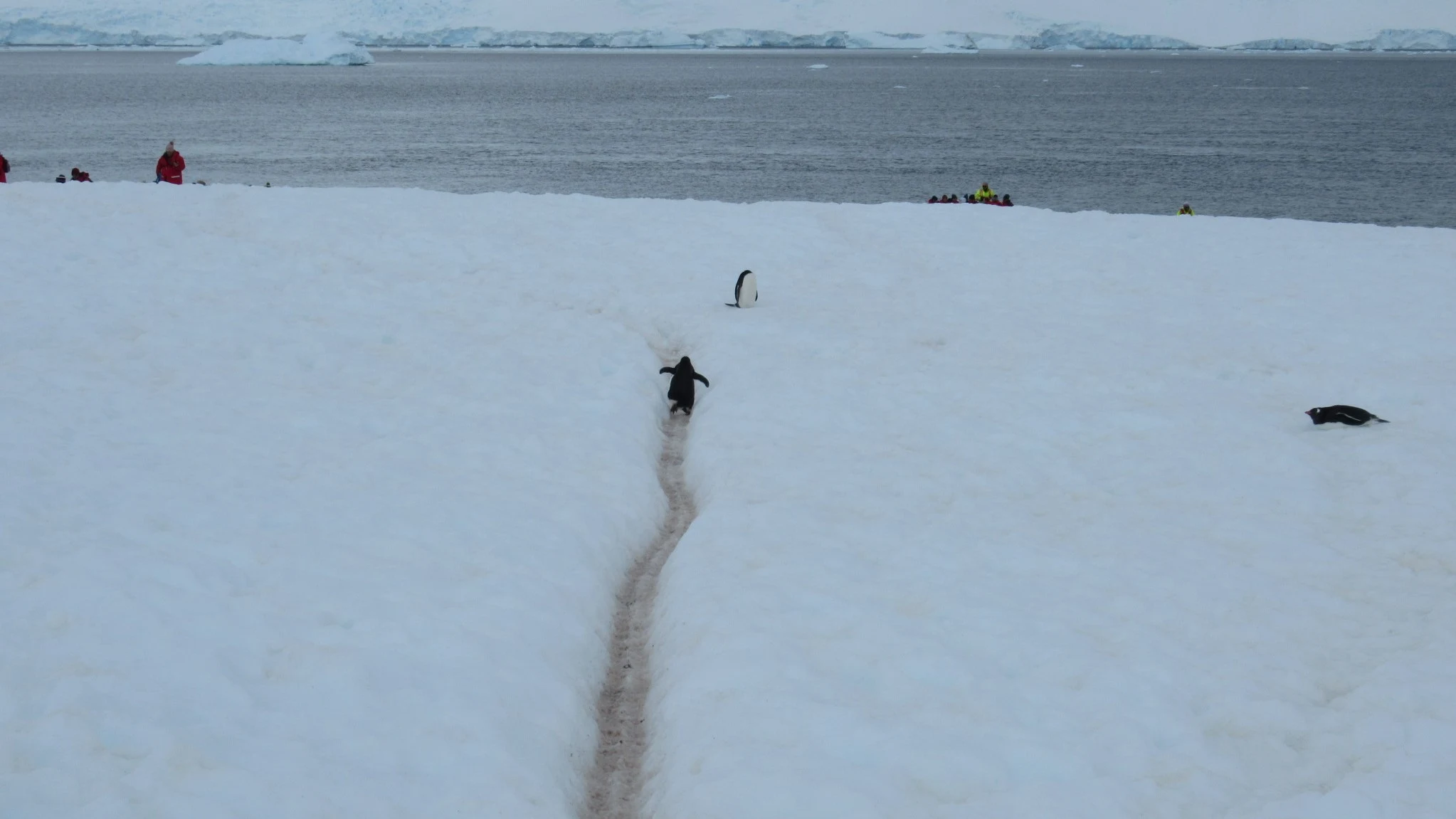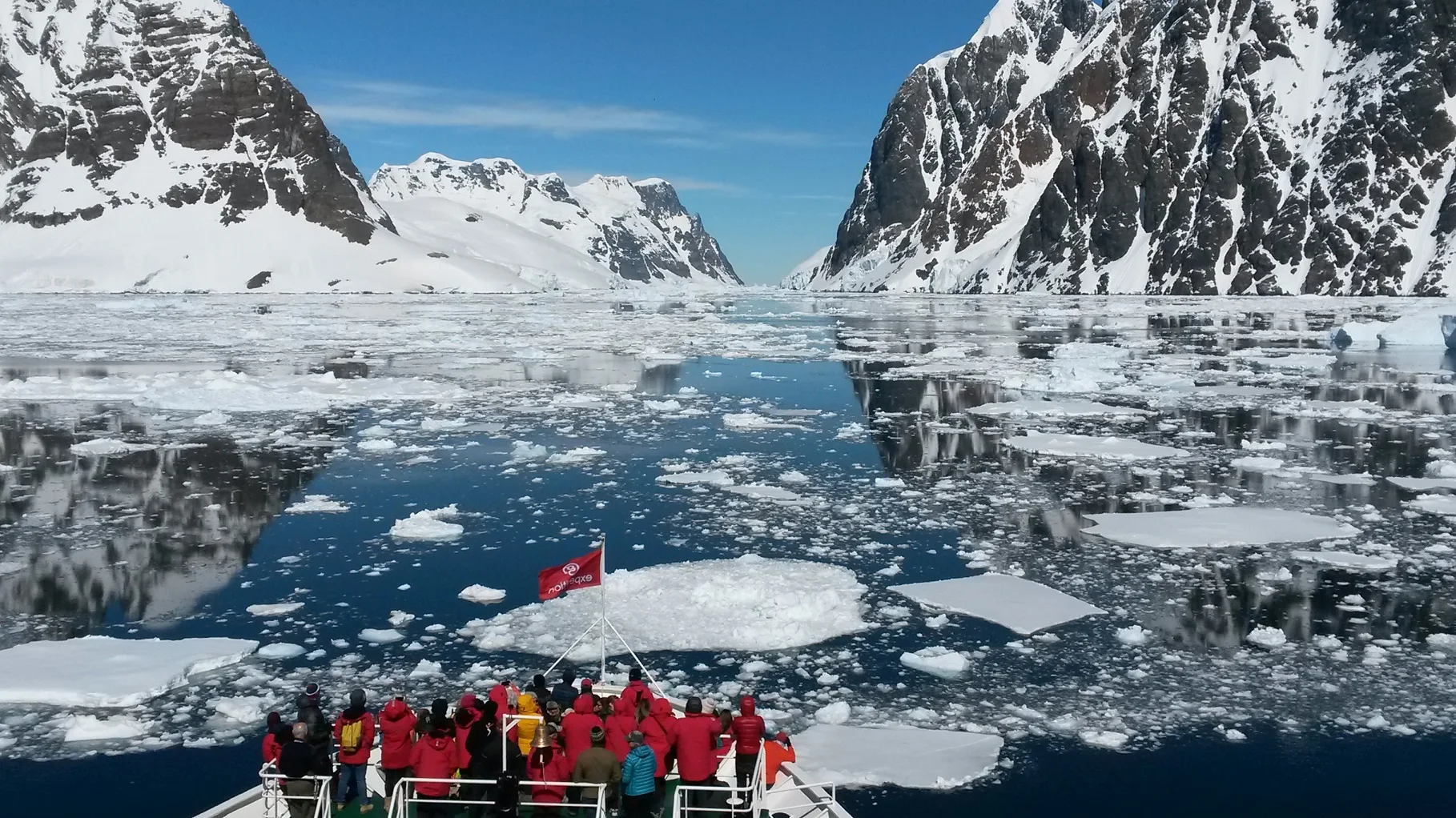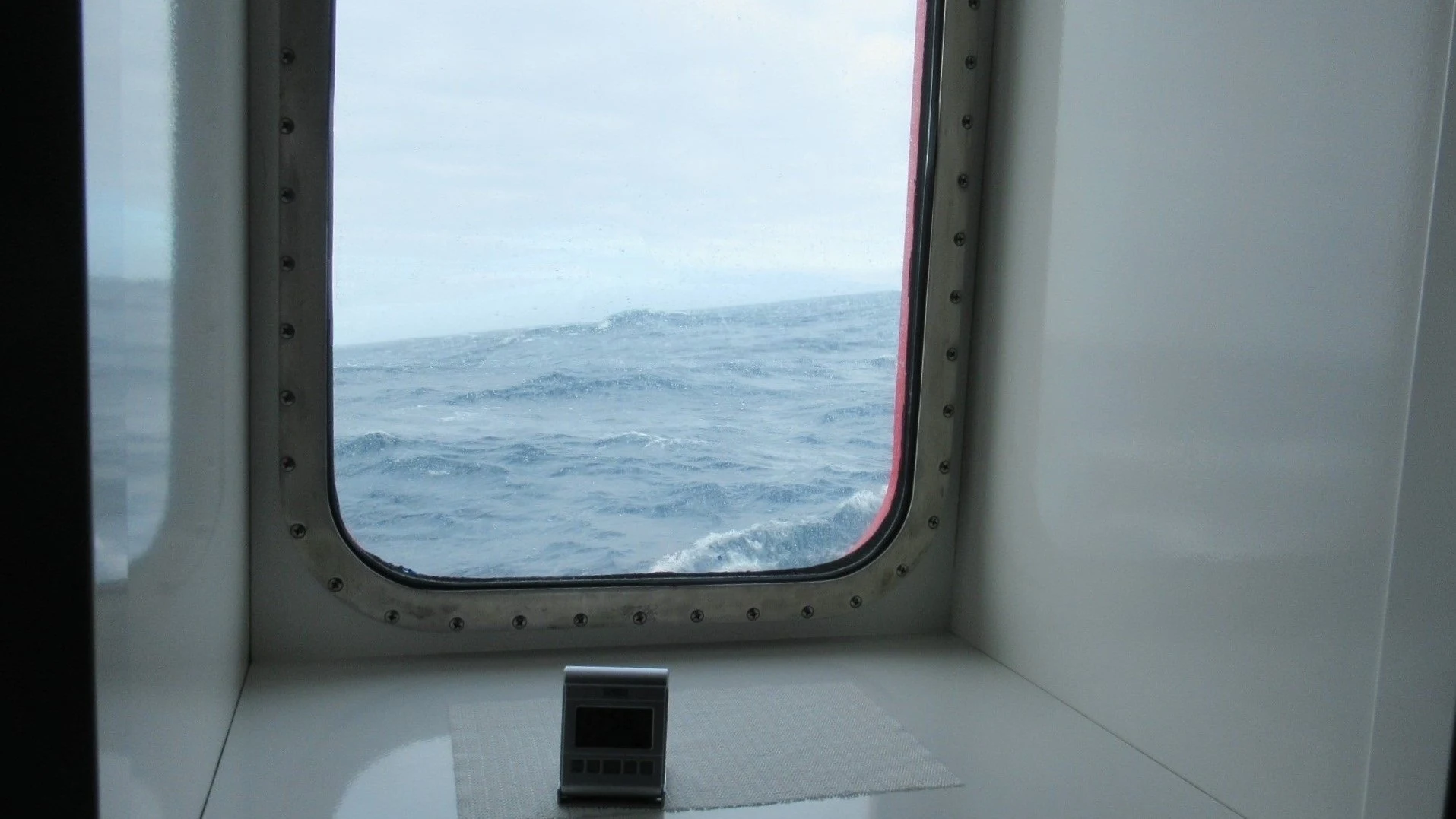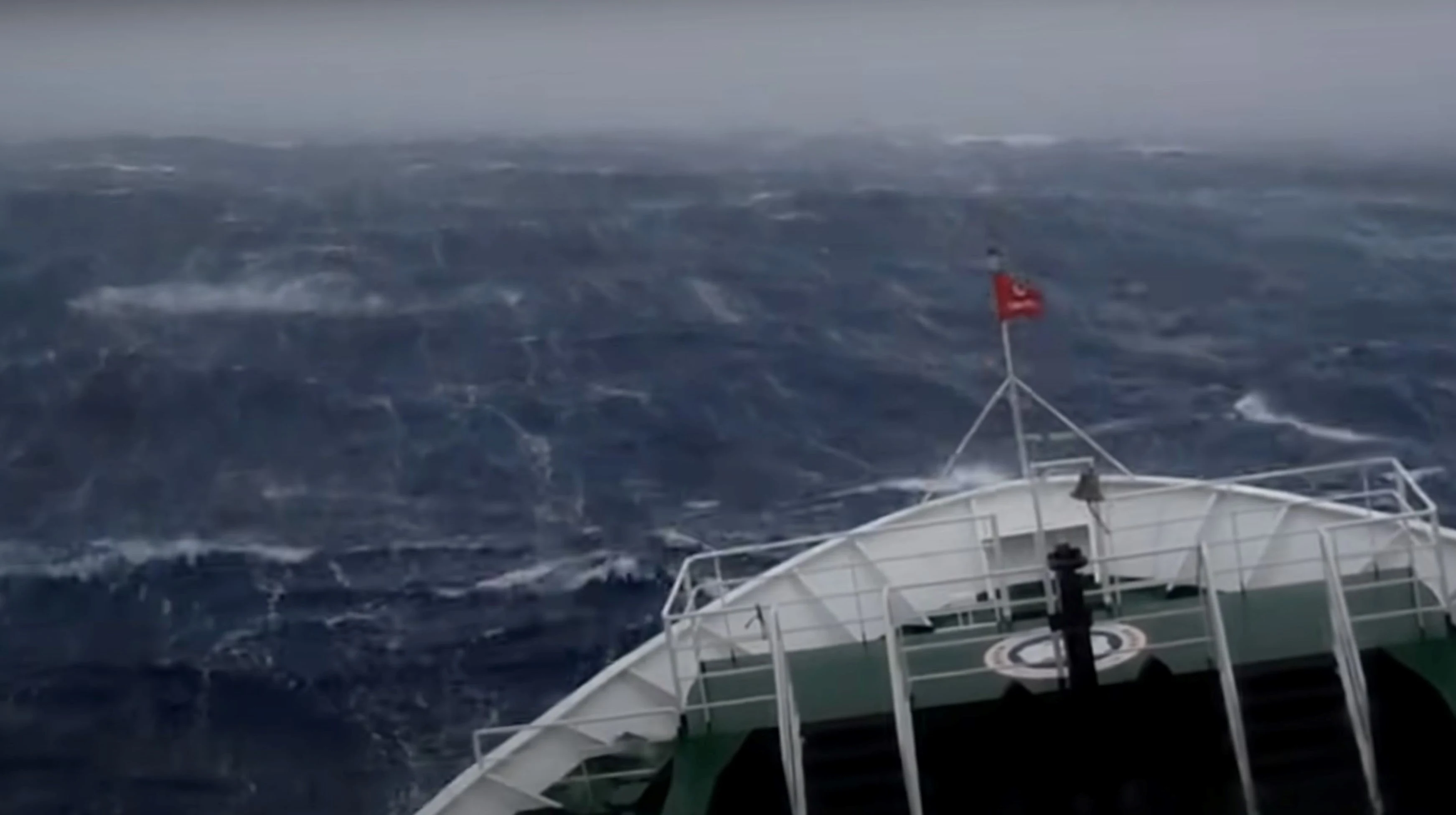After arriving in Buenos Aires at the end of a motorhome tour around Patagonia, Chile and Argentina, we flew to Ushuaia, a city at the southern tip of Argentina. We went there to embark upon a 10-day cruise to Antarctica, the largest ice-store in the world.
Along with its ice, Antarctica is the world’s driest, coldest, windiest, and highest continent, and also the 5th largest at 14.2 million sq km (5.5 mill sq miles). It has huge icebergs, an interesting history, and a variety of penguins, whales, seals and seabirds. We were really looking forward to being there.
But first, Ushuaia. This city sits on the shores of the Beagle Channel at the bottom point of South America. It is the world's southernmost city, and often called "the city at the end of the world". It is the nearest departure point to the Antarctic Peninsula which is around 1,000 km (620 miles) away.
 |
| The main street in Ushuaia, Argentina |
We had two nights in Ushuaia so went out exploring the city. We liked the colourful houses and shops, steep streets, and the vibrancy of the place.
It's a smallish city, with a resident population of around 57,000 that swells considerably in the tourist season. There seemed to be plenty of tourist about when we were there, and they were easy to spot because they were all wrapped up against the cold, like us!
 |
| Prison at the End of the World Museum, Ushuaia, Argentina |
We visited several tourist places there, including the Museo del Fin del Mundo (End of the World Museum). It used to be a jail, but now has some great displays about the history of this area.
We also had an asada, a traditional dish of Argentina, Chile, Paraguay and Uruguay. It is meat cooked on an open fire or a grill called a parrilla. The locals tend to cook it as a whole lamb on a spit over hot coals. It is so very delicious.
After a couple of days in Ushuaia, we boarded our ship to Antarctica, the MS Expedition operated by G-Adventures. She was to be our home for the next ten days.
During the boarding process, we had our photo taken for an identity card, and were then put into groups for shore-landings and short trips. A zodiac inflatable boat is used for this, and each zodiac group was given the name of an Antarctic penguin. We were the 'chinstraps' after chinstrap penguins.
Finding our cabin was the next step, and it turned out to be on the port side.
To our great delight, we had been upgraded from a porthole cabin to one with a large window. It was very spacious compared to the motorhome we'd just left in Buenos Aires.
The MS Expedition takes a maximum of 132 passengers and there were 110 for this trip. Our fellow passengers included a lot of Americans and Aussies, quite a few Brits, and a smattering of Europeans. There were only six of us Kiwis.
We were soon off out of the harbour and into the Beagle Channel. Not long after that, we entered the notorious Drake Passage.
The Drake is the body of water that runs between South America and Antarctica. It is the meeting point of the Atlantic, Pacific and Southern oceans and the clash of these three titan oceans, tends to create very turbulent seas. So, we expected the weather and seas to be really rough for our two-day crossing.
However, we were very lucky - apart from a bit of rocking and rolling on the first night, we had relatively calm conditions and sunny days.
Marg had prepared for seasickness with a patch and pills, so was very pleased to feel ok and relaxed.
The weather was so good that we made speedy progress. The time gained, meant we we're able to make an unplanned zodiac landing in the South Shetlands, a group of Antarctic islands in the Drake Passage.
Before arriving there, we were issued with a super-padded waterproof red parka each (which we got to keep), and gumboots (which we didn’t).
It was cold out, so under our red parka we wore thermals with 2 or 3 layers of tops, trousers, waterproof pants, a hat, scarf, and 2 sets of gloves. We looked like little chubbies!
All wrapped up, we boarded a zodiac for our landing in the South Shetlands. All landings on this expedition are shore landings with no piers or wharves. So, after a choppy shore landing, we took our first land-steps on this amazing trip.
We felt quite prepared for the super-cold weather with all of our layers of clothing on. However, we were totally unprepared for the monochromatic beauty of the place. It was stunning.
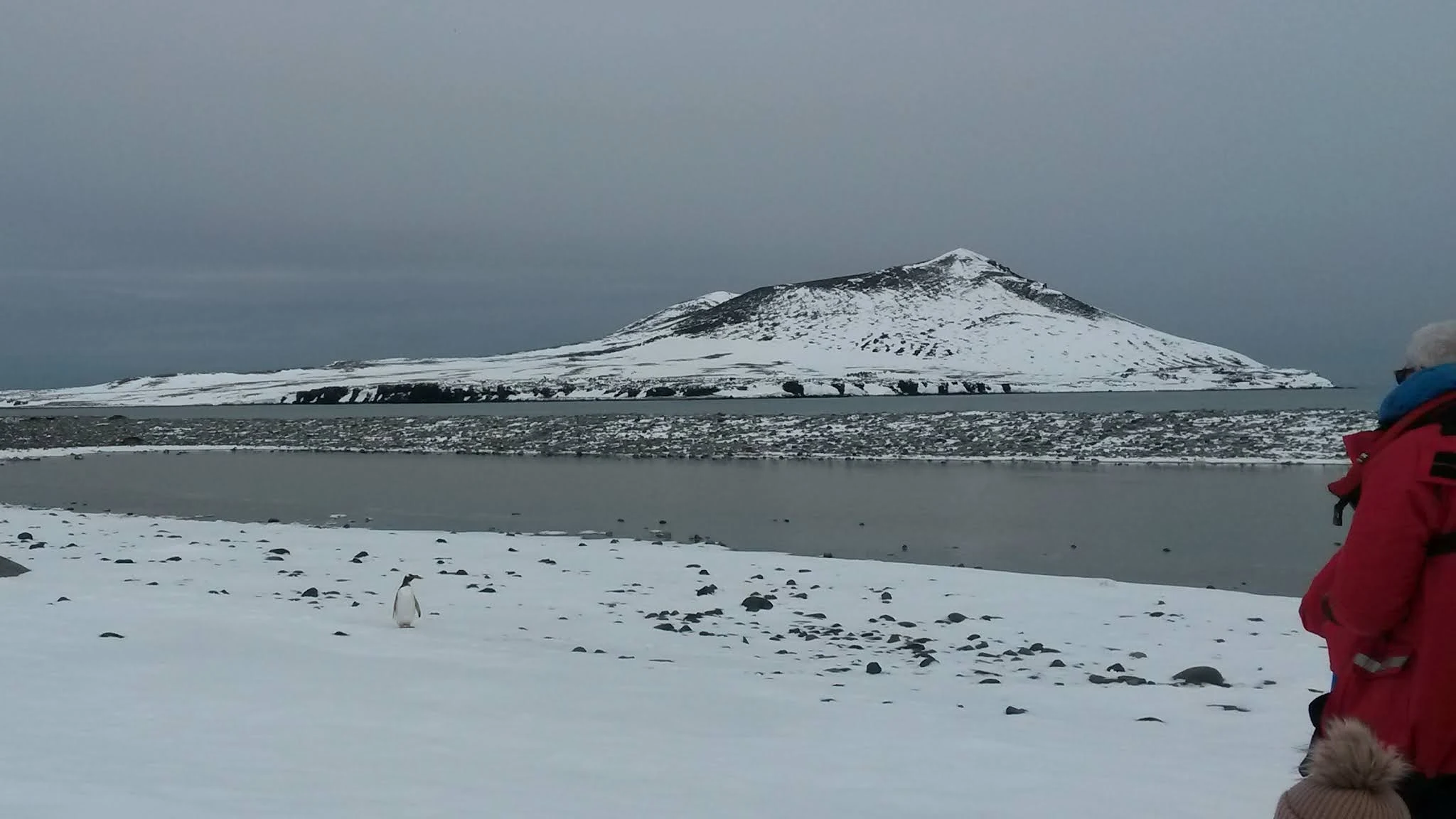 |
| King George Island, and our first tiny penguin (bottom left of photo), Southern Shetlands, Antarctica |
We were on King George Island, the largest of the South Shetland Islands, which we had heard, abounds with penguins and elephant and fur seals. And indeed, just stepping onto the shoreline, we spotted our first penguin.
In fact, we were really lucky as we saw three types of penguins there. They were adélie, gentoo, and chinstrap penguins. As our zodiac group was called 'The Chinstraps', we were very excited to see those penguins in particular.
 |
| Penguins: Top left - a chinstrap. Top right – two adélies. Bottom - gentoos |
These three species are all a similar height being between 68 cm (27 inches) and 71 cm (28 inches) tall.
We also saw plenty of seals. Most of them were lying about on land, and were easy to spot as they look like chubby dark-brown blobs on the white snow.
A few chose to frolic in the icy shallows of the beach, and we spent ages watching them. They appeared to be really enjoying themselves, and were totally unperturbed that we were watching them.
This first experience on the snow and ice was so exhilarating.
Our next stop was the Antarctic Peninsula, and on the way, we went through a wee snow storm. Being in falling snow is a bit of a novelty for us, so we went out on deck to enjoy it. We were definitely in a very cold place!
In the morning, we sailed into Neko Harbour. We were surrounded by icebergs, snow covered mountains, and glaciers, some of them calving with big bits of ice cracking off and crashing into the water. It was a truly awesome sight.
Then we had our first landing of the day and walked past many gentoo penguin nests. Neko Harbour is an important bird and biodiversity area as it supports a colony of more than 250 breeding pairs. They are noisy little things and certainly have a distinctive smell!
They didn't seem too concerned that we were there. It was fabulous to be able to get so close to them on their nests.
They spent a great deal of time collecting stones to build their nest, often stealing these from the neighbours. It created plenty of action and noise when the theft was discovered.
Our second landing was in the early afternoon on Danco Island, where there were even more gentoos nesting on bare rocky patches.
In order to get from nest to sea, the penguins mostly travelled along ‘penguin highways’; deep tracks they had made in the snow from repeat trips along the same path. They were really cute bobbing up and down these highways, and seemed ok with us being there, as long we stood back quietly to let them pass.
Later that day, we cruised through some huge icebergs around Danco Harbour, and managed to get up very close to them in the zodiac. It was amazing.
We saw one that had recently rolled over showing its dimpled bottom.
Another highlight of this day was seeing our first minke whale. They are a smallish by whale standards, surface only briefly, and are very hard to spot.
The next day, the ship prepared to sail through the Lemaire Channel. We were told that the Channel had been completely blocked with ice a week or so earlier, and that we may not get through.
However, the Captain was prepared to see if he could get through the ice this time, to reach the other end of the Channel.
We moved very slowly in the calm and reflecting water, as large chunks of ice thumped against the hull.
Looking ahead, all you could see was more and more ice and icebergs, as the ship moved slowly but relentlessly toward the end of the Channel - a wee gap on the horizon. It was both daunting and fabulous!
Before long, everyone was out on deck with their camera. But photos don't do justice to the beauty of the snow-topped mountains reflected in the still waters of the Channel, and the huge number and size of the pristine ice floes.
Arriving close to the southern end of the Channel, a zodiac was sent out to check the ice conditions ahead.
Eventually the Captain announced that there was still a huge wall of ice blocking the channel, and the ship could not get through.
So, he carefully turned the ship, and we sailed back the way we had come, marvelling at how much ice we had forced our way through to get there.
During the return journey, we spotted, a huge (about 3 metres long) leopard seal snoozing on an iceberg, more penguins, and another minke whale.
As we saw the various sights, the ship's expedition team would tell us more about what we'd seen, and were very knowledgeable. If we wanted further information, we could attend lectures about a range of things, later in the ship's lounge.
Later that day, we had a zodiac trip to see some really incredible icebergs that were all shapes, sizes and colours. Again, it was fantastic to be able to get so close to them.
While out in the zodiac, we were privileged to spot what is called a 'raft of penguins'. This is a large group of penguins swimming together on the surface of the water, while chasing food. It was an incredible sight.
Our zodiac driver said she had been working in the Antarctic for years and it was only the second time she had seen this.
Still out in the zodiac, we came across another huge leopard seal; this one was in the water.
Then we spotted two little pink feet sticking out of its mouth – it had caught a penguin. Not a pleasant sight as it threw it in the air and slapped it down in the water preparing to eat it.
It was a wee insight to the food chain in the Antarctic.
Back on the ship and moving again, we were treated to another amazing sight. It was a group of humpback whales right in front of the ship, bubble-net feeding.
They swam in front of us, diving then surfacing, and creating lots of bubbles. The bubbles apparently disorient fish so that the whales can corral them and feed on them.
They were swimming and diving in all directions as they fed right in front of us, and we had an incredible view of their very large bodies.
About 40 minutes later, they moved away and we continued on our way too, feeling very privileged to have witnessed such an event.
After breakfast the next morning, we set off in zodiacs for Port Lockroy and an Antarctic Treaty Historic Site called ‘British Base A’. Established during WWII, it was the first permanent British base on the Antarctic Peninsula. Now, it is the most southerly operational post office in the world, and they process around 70,000 pieces of mail there every tourist season.
The base is an amazingly preserved old building containing all sorts of historic items such as tinned food, clothing, communication equipment, and everything else that was needed to live there in past eras.
It has been run as a museum and post office for tourists since 2006, and is currently staffed by a team of three women, accompanied by a colony of nesting gentoos.
Apparently, every year the team is sent new brooms to clean up the penguin droppings outside the building, with the staff admitting that it often looks like a penguin toilet!
After a look around British Base A, we crossed the bay to Jougla Point, where we walked on sea ice; apparently, a rare event at this time of the year. It was incredible to think there was deep, freezing water right under our feet.
We also saw lots of blue-eyed shags there. Their eyes really are an amazing blue.
Later, we cruised up the Neumayer Channel to Paradise Bay.
Out on the zodiacs again, we had a very upfront view of some amazingly shaped, blue coloured glaciers and icebergs.
We had recently seen several well-known glaciers in Patagonia and those in Paradise Bay were much bigger and, in many cases, older. Some of the iceberg shapes were incredible; all crafted by nature.
In the afternoon, we landed at Damoy Point Research Station. Beside the Station, was a mountain peak giving a great view out over the bay. We both climbed up there, but it was very tough going, climbing upwards through the snow. It was very thick, soft and deep - knee deep for most (thigh deep for short folk like Leigh).
After admiring the view, we slid down the long steep snowy slope on our bums. Woo hoo – what an adrenaline rush, and lots of fun.
We would have had a second go except it was just too hard to struggle back up to the top again through the deep snow.
The last morning of expeditions saw us enter Whalers Bay on Deception Island. The bay is actually the crater of a submerged active volcano.
We saw the remains of an old whaling station there. It had an eerie feeling to it with the white snow, black and red scoria sand on the beach, and ramshackle rusty, derelict buildings.
The station was abandoned when the whaling industry collapsed in the 1920s. The buildings slowly decayed and were then further damaged by volcanic eruptions in the 1960s and 70s.
The huge, old whale-oil vats were looking like soldiers on parade, but not quite lined up properly.
The whole area had a mystical look, with the steam rising up off the water and sand from the volcanic activity below the surface.
While the edge of the water was warm from the thermal activity, less than a meter out it was absolutely freezing. However, some crazy people went for a swim, while the sane ones like us stayed on shore.
In the afternoon we sailed to Half Moon Bay then climbed through very deep snow, to see a large colony of nesting chinstrap penguins. Once there, we were surprised to see, right in the middle of the chinstraps, a cute, lonely-looking macaroni penguin with its weird yellow haircut.
Macaroni’s are rarely spotted so we were very lucky.
Who knew what our macaroni was thinking when he mucked in with the chinstraps, but they appeared to accept her/him. It seems nature deals well with diversity. It makes one wonder why humans struggle with it so much.
Our ship had a range of entertainment for us every night such as Catherine, who with her great voice and talented guitar playing, entertained us into the wee hours in the Polar Bear Bar.
On the last night, they showed the movie Happy Feet. A very appropriate movie considering how many penguins we had seen.
So, lots of things to do if you had the stamina after such busy days!
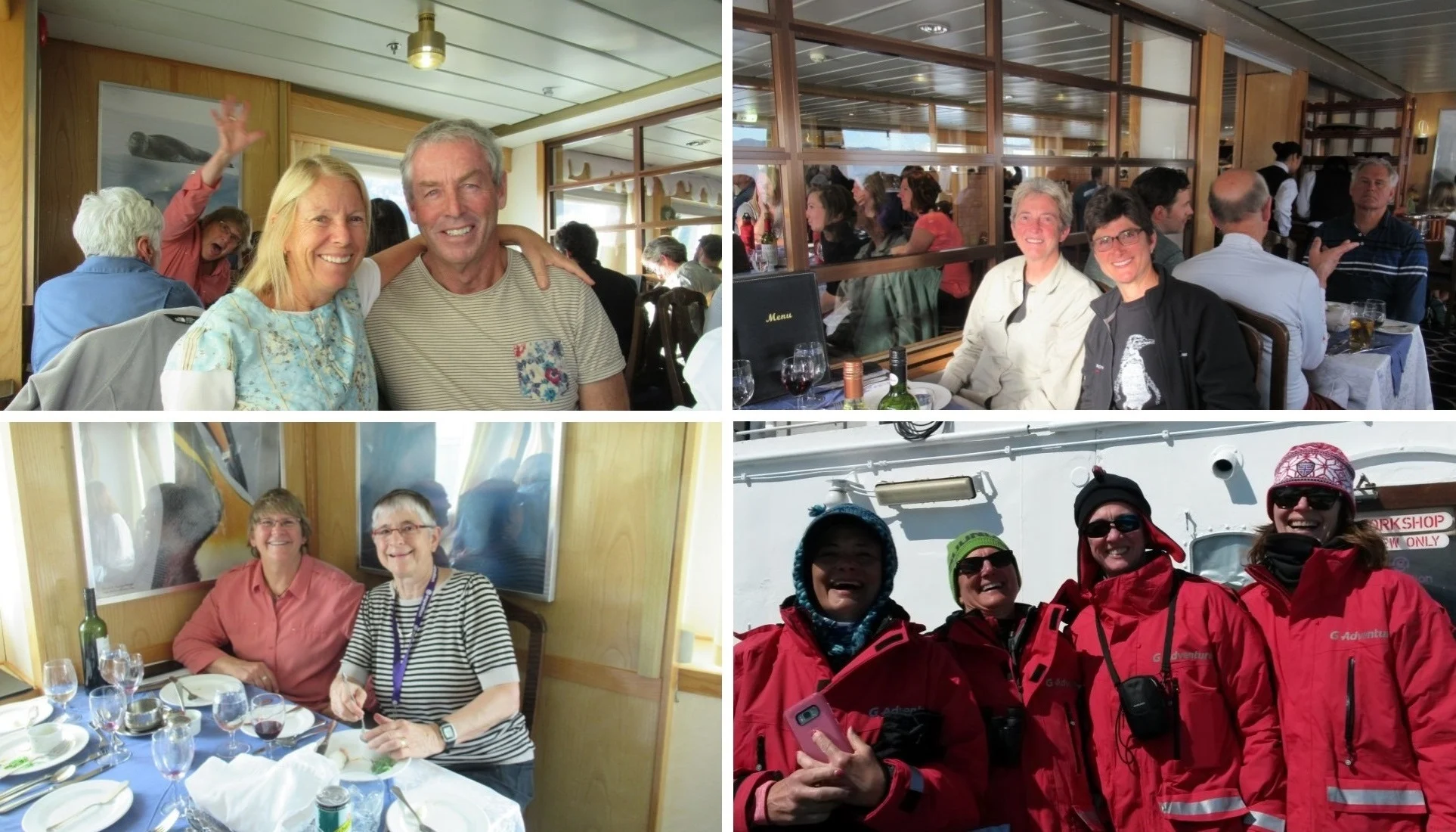 |
| Cruising mates-Top: Debbie and Gary (Aust). Brenda and Julie (Seattle). Bottom: Sandy and Chris (Seattle). The Seattle four |
At meal times you sat at whatever table you liked, so it was a good way to meet new people. We met some great folks; Debbie and Gary from Mount Coolum on Australia’s Sunshine Coast, and a group of women from Seattle in the USA, whose company we really enjoyed as the trip progressed.
The food was fantastic with lots of choice, and we became a bit concerned about how much weight we might put on if we kept trying all the food, including desserts!
Too soon, the time came to head back across the Drake Passage to Ushuaia. However, this time, the Drake lived up to its reputation.
Our first inkling of rough seas was seeing the angle of the horizon when we looked out of our cabin window. Then everything started sliding around a bit. However, we were hungry so went to dinner as planned.
Everyone was eating dinner when we all noticed the wind and swell suddenly picking up. The next minute, everything on the tables started to move and roll. Wine glasses fell over, plates started sliding off tables, and it became hard to stay seated and eat at the same time.
So, along with everyone else, we left our food immediately and headed to the refuge of our cabin.
The sea grew increasingly rough and we held on for dear life in our beds, trusting that the captain knew what he was doing! But, as the night wore on, the ship's rolling and bucking became more alarming. Leigh swears that the ship listed to 45 degrees on more than one occasion.
The next morning, we were told that the night’s storm had been a force 10 gale with winds between 89 - 102 km/hr, and a heavy rolling sea!
Not pleasant, but we were happy to have survived with no sickness, or damaged belongings.
During the storm, the captain had headed for the famous Cape Horn for overnight shelter, and in the morning, we found ourselves anchored around three kilometres out, with a great view of it. Such a bonus as ships on our route often don't get to this famous rock.
The storm we experienced was terrible, but not the worst that the Drake has to offer. It’s not hard to imagine how the ships and lives that have been lost there over the centuries, were caught out.
We cruised on into Ushuaia that evening for our last night on the ship, before disembarking the next morning.
We sadly said goodbye to the friends we had made on board, and headed to our hotel thinking of all the amazing sights we had seen on the beautiful continent of Antarctica. We won't ever forget this trip.
But we are looking forward to being on land for a bit, so are spending the next few days in nearby Tierra del Fuego National Park.
The above blog is part of our 4-month tour of South America. The first blog on this tour is called "Buenos Aires here we come".









